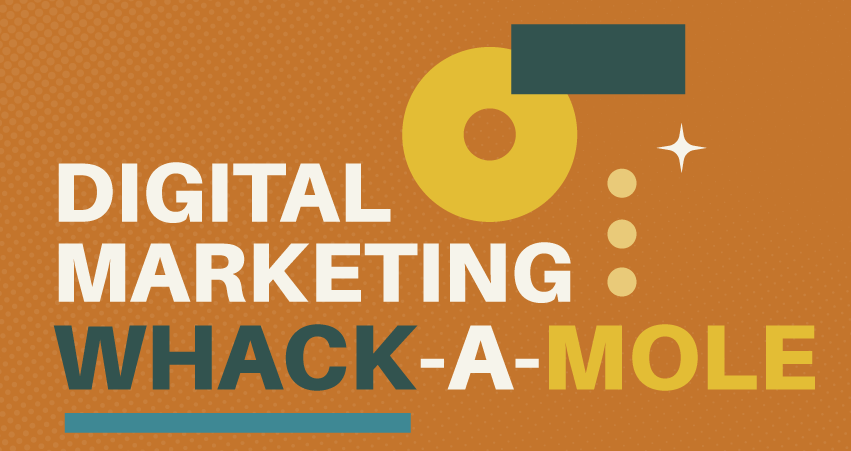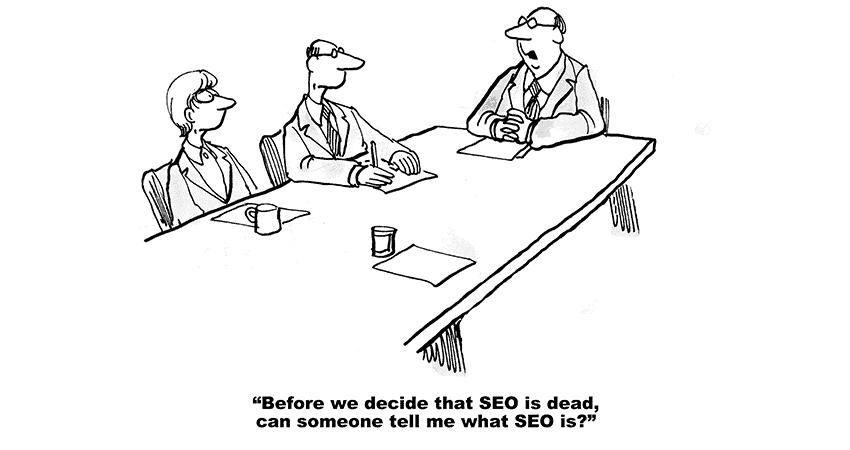Digital Marketing Whack-a-Mole: 15 Fibs & Fallacies That Won’t Stay Down

Digital marketing is the process of promoting products and services over the internet. It includes SEO (search engine optimization), paid search, website design, CRO (conversion rate optimization), email automation, and so on.
Done right, it can lay an ant trail for customers to find your business. Done wrong, it can bore a gaping hole in your budget as you pour resources into unproductive campaigns.
Wrong-headed campaigns are all too common, especially when motivated by false assumptions.
Here, we’ve listed some of the more persistent and pernicious fallacies we encounter in our dealings with people outside — and sometimes inside — our hallowed digital marketing halls.
Like the proverbial Whack-a-Mole, they always seem to reappear.
1. “I don’t need a website. I have a Facebook page!”
Bully for you.
Less than 64% of small businesses have a website. 70% to 80% of potential customers research a company online before visiting it or making a purchase (Blue Corona). They’re not doing much research on Facebook.
Houston, we have a problem, or at the very least, a disconnect.
Your website is your digital home base. You control it completely, from the messaging to the layout to the search engine optimization. It says more about your business than a social media profile, and it has the potential to drive far more traffic.
Plus, when it comes to the Google Map Pack that generates anywhere from 30% to 50% of all calls for Culture Cube small business clients, Google doesn’t care that you have a Facebook page. But Google cares about your website and expects its information to be thorough and accurate.
2. “If I build it, they will come.”
Over half of small business websites average fewer than 16 visits per day. Of those visits, maybe a third are local. Maybe. That’s not enough traffic to generate even a sniff.
Make sure your web designer understands SEO principles and incorporates them into your site. Post as much quality information about your business as you can. A page with a single list of bullet points won’t cut it with search engines.
Ask your marketing firm how they plan to promote your site beyond the launch date. Be prepared to invest in paid search, social marketing, display ads, and link-building to seed the site with traffic. It can take several months and even years for SEO to mature.
Google (here we go again) doesn’t give a hoot that your site is the prettiest in town. But if your site architecture, internal linking, web copy, offsite marketing, and page load speed are on the mark, the Google gods will bestow their blessings — eventually.
3. #1 keyword rank gets you (insert inflated percentage) of clicks!
You’ve heard the mantra: if you’re not on page one of the search results, you’re nowhere. If you’re in organic position #1, you get up to 40% of the clicks!
Poppycock.
I spent years analyzing the data of a multi-million dollar “category-killer” e-commerce site.
Typical clickthrough for top-ranking non-branded keywords ranged from 2% to 20%. Even branded keywords seldom reached clickthrough rates above 25%.
Google Ads, the Map Pack, image results, and video have pushed organic listings further down the search results page (SERP). Google’s Knowledge Graph, Google Maps, embedded business profiles, and such provide so much information that many prospects never venture past the SERPs.
Forget about the coveted top position. It rarely translates into the traffic you want and is almost impossible to maintain.
Plus, Google looks at a searcher’s history, preferences, and location and delivers different results based on context.
Focus less on keyword position and more on getting your listing in front of as many searchers as possible: in the Map Pack and organic results, for starters.
4. SEO (search engine optimization) is dead.
*Sigh*
I wrote a whole stinkin’ blog post about this.
Black hat SEO, or the SEO of tricksters and charlatans, is on the way out, thank goodness. The tricksters now lurk in dark corners, still firing unsolicited emails at unsuspecting business owners, always promising results too good to be true.
Their tricks don’t work the way they used to.
SEO is more complex and time-consuming than it used to be, but the rewards are great.
What matters today is:
- Sound technical SEO (how you build your site).
- Quality web copy and blogs that address customer questions and concerns.
- Site freshness: ongoing updates to keep your site current.
- User experience: a site that’s easy to use, mobile friendly, and fast loading.
- A social media or offsite presence.
- Links from other quality websites.
- Google Business Profile optimization: a verified and complete profile with images, business categories, services, hours, and more.
- Google Reviews: ratings quality, volume, frequency, and recency.
Some Culture Cube clients get 80% of their website traffic from organic searches, amounting to hundreds of visits daily. A portion of those visits converts to sales.
All that “dead” SEO is keeping them in business.
5. Social media is the new website.
Uh, no.
Social media platforms are powerful marketing tools. But they have little impact on your local visibility and will drive little business compared to an optimized website.
We’ve learned that some clients need a solid social media presence; others don’t.
Facebook, Instagram, and Pinterest make perfect sense for a garden center, custom glass company, or high-end window treatment business to put their wares on display, post information about special events, advertise coupons, and hold customer conversations.
Plumbers and electricians have no time to converse with customers on Facebook. They’re busy plugging leaks and installing panel boxes.
We recommend a small social presence for most local businesses and focus our marketing efforts on website design, copywriting, blogging, citation building for backlinks and localization, and Google Business Profile optimization.
6. More traffic = more sales.
This is the most unrelenting digital marketing myth of all. Website traffic doesn’t automatically translate to leads and sales. Your site could be attracting tire kickers or, more likely, traffic from outside your business area.
Worse, your website UX and messaging could be working against you:
- Badly written copy.
- Weak assurances and value propositions.
- Confusing navigation.
- Poorly designed forms.
Blogs boost traffic but won’t drive local traffic like your service pages, service area information, and Google Business Profile.
Make the most of your traffic with a user-friendly site, excellent customer service, and a frictionless conversion path.
7. The more keywords on a page, the better your chances of ranking.
How often have I heard this one: if we insert (their choice of pet keyword), the page may rank!
Lord, give me patience.
Keyword stuffing doesn’t make your page relevant for those keywords or the best destination for search.
Google and other search engines have moved beyond keyword density and now read pages with near-human understanding.
If you want your page to rank, write for humans, not search engines. Information, not fluff.
Have keywords become irrelevant? Not at all, but keyword spamming won’t help your page rank and will probably hurt it.
Create your pages around focused ideas and keyword themes. Google looks for “proof terms” as much as any keyword you may be targeting. Proof terms are closely related to the target keyword; think of them as word associations for search engines.
Proof terms for a page about leak repair might include corrosion, old pipes, broken pipe, flooding, leak detection, and slow leak. Surely you can insert a few of those as you explain in detail the benefit of your leak repair service over others.
8. The bigger the site, the better the traffic.
A single blog post can generate thousands of daily visits. It happens rarely, but in the content you develop, there will be all-stars and losers. Three or four all-stars may account for 30% of your organic traffic. Forty losers may contribute nothing at all.
Quality is the key to organic traffic, not quantity. Spend your next two days on a well-researched, helpful, and thorough blog post, not six pages of junk.
That said, it’s unusual for a small website to see much organic traffic. You need to establish yourself as a subject authority and should have a solid platform with enough content to be a factor.
A basic local service site should host at least 30 pages of original content, plus location and service area ages. The more detailed and focused, the better. If you write about one thing well, you’ll likely rank for related keywords too.
9. Your website is a finished product.
You’ve launched your new website. You paid the designer. Woohoo! Task complete! No more digital marketing bills, except for hosting!
Sorry, no.
Your website is never done. You should be tweaking and improving it, adding more content, enhancing the user experience, etc. The internet changes too fast for a site to sit.
Google makes several algorithm changes a day and thousand a year, some of which are beyond the control of Google’s own developers.
Plus, a neglected site signals to Google: nothing new here! No need to revisit and reindex a site.
Google crawls the sites it deems important and indexes only a fraction of the total pages on the internet. Any page excluded from Google’s index has no chance of ranking. None. Maybe on Bing if you’re willing to wait for Bing to catch up.
- There are over 1.88 billion websites as of 2021 (Statista)
- Less than 200 million websites are active (Review 42)
- One of those “inactive” websites might be yours (Culture Cube)
A good rule of thumb is to budget at least 20% of your original design cost annually to keep your site fresh and relevant.
And if your goal is to dominate your local market, you’ll need to fatten the budget and invest in SEO.
One page of well-researched and search-optimized copy can take a day or more to write. And you shouldn’t hire interns to write it, but professionals who know what they’re doing.
10. You need a big budget for digital marketing.
“I don’t have $5,000/month for SEO.”
Our response is always the same: “You don’t need $5,000/month for SEO.”
You can start with as little as $500/month and see results.
Culture Cube’s customer onboarding fast track at Culture Cube begins with a small investment and ramps up as new business rolls in:
- We verify and optimize your Google Profile.
- We initiate a citation campaign to boost your location signals.
- We create high-performing paid search campaigns.
- We make minor enhancements to your site (if possible).
- We rebuild your site with a firm foundation of SEO.
- We promote your new site: offsite marketing, email, social, etc.
- We enhance the SEO with new pages, site improvements, blogs, etc.
- We design dedicated landing pages to optimize paid search.
11. “I can do it myself.”
Bless you; you’re our kind of customer.
But if things are going so well, why are you talking to us now?
Digital marketing demands ongoing attention, maintenance, content creation, and technical know-how. If you’re serious about online sales, you need a content team that can use keywords naturally without sacrificing readability or violating Google’s quality guidelines.
Your website should be fast-loading, mobile-friendly, and easy for customers to use. Have you thought about UX? Form design? User click behavior? Font load optimization?
We have.
We love it when our customers contribute: send us your notes, outlines, and sketches, and we’ll spin them into blogs. Tell us what new service you want to promote.
But leave the execution to us. We’ll make it look good, sound good, and rank well.
12. Experience = competence.
If only it were true! And generally, it is true until you meet the glaring exception: the veteran graphic artist who ignores UX, the SEO who can’t communicate, and the category manager who doesn’t consider the customer buying process.
These drones exist everywhere, even in the Ivy League of digital marketing.
How do I know?
Because I witnessed one of the most respected agencies on the planet systematically damaging the SEO on a site I managed. Their recommendations were outdated. Their work was shoddy and indifferent.
Always vet the agency you hire. Ask who’ll work on your account and for evidence of success. If the agency is a good business partner, they won’t mind that you do
13. Customers read copy line by line.
Of course, they do! Because they’re so interested in what you have to say!
Except, when was the last time you read a web page from top to bottom? Probably never.
Customers don’t read web pages — they scan. Their eyes dart from heading to heading. They collect information in fragments.
Dense blocks of copy are the bane of online readers and usually encourage a quick exit.
So you have to adapt:
- Frontload the essential information on a page. Don’t bury it in the middle!
- State your value propositions clearly and quickly.
- Use lots of information-rich headings.
- Format in bullet points — they’re easy to scan.
- Write at an 8th-grade level so that everyone can understand you.
- Keep sentences and paragraphs short.
- Images, infographics, and videos help break up the copy and add visual interest.
14. The lowest price usually wins.
If this were true, you’d never find parking at the Dollar Store. I’d lose my favorite hangout.
We’d don’t deny that all else being equal, price is a dominant factor in a purchase decision. But most purchases are value-driven, not price-driven. Customers will pay more for a local service if it comes with iron-clad guarantees and first-rate customer service.
You don’t want to price yourself out of business. But more than anything, you should sell the value of your service and communicate that clearly on your website, social media pages, and email campaigns.
15. Customers are always right.
No, they’re not! They’re often misinformed, emotional, and irrational — which is why they need you to help them make the best decision. And they may burn you with a one-star Google review, even when you never worked with them!
Still, you should give them the benefit of the doubt, even if they’re wrong. Always be professional, helpful, and polite — even if they’re not.
Your phone manners and customer service will go a long way toward converting disgruntled customers into brand evangelists and reducing negative chatter on the internet.
Further Reading
- What is readability and why should content editors care about it? (Center for Plain Language)
- How Users Read on the Web (Nielsen Norman Group)
- Setting value, not price (McKinsey & Company)
- Over 50% of Local Business Websites Receive Less Than 500 Visits Per Month (Search Engine Journal)
- SEO for web designers: What you should know (Search Engine Watch)
- The Google engineer who thinks the company’s AI has come to life

Peter Losh is the SEO Director of Culture Cube Marketing in Upland, California. He's also a de facto UX designer, site builder, and content creator. Unlike most folks in the SEO biz, he works directly on the sites he optimizes, having witnessed the effects of recommendations that go ignored or misunderstood (in previous gigs).
Peter has worked on websites since the salad days of the internet, first as a graphic artist and web designer at the Centers for Disease Control. Then came several years of freelance web development, SEO and e-commerce management for business sites of various sizes, and ultimately a 10-year stint as the sole SEO Manager of PartyCity.com.
In his spare time, he enjoys classic film, classical music, and classic comebacks. And cats.
Professional Work Experience
- Search engine optimization
- Ecommerce management
- Conversion rate optimization
- UX design and analysis
- Copywriting and training
- E-mail campaign design
- Web design and development
- Graphic design


